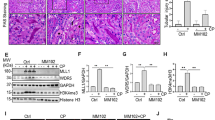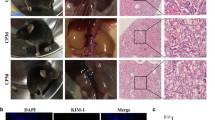Abstract
Background
Sirt1, a mammalian homolog of silent information regulator 2 (Sir2), is the founding member of class III histone deacetylase (HDAC).
Methods
In this study, we examined whether Sirt1 is involved in the modification of acetylated histone H3, acetylated p53 and Werner syndrome protein (WRN), which is stabilized by Sirt1-mediated deacetylation, in cisplatin (CDDP)-induced acute renal failure (ARF) in rats.
Results
Administration of CDDP (5 mg/kg body weight) caused an increase in the Sirt1 protein level by 6 h; this increase peaked at day 5 and declined until day 14. Sirt1 was induced to a greater extent in rats with severe ARF. In contrast, HDAC3 and HDAC5 were not induced within 24 h after CDDP administration. The level of acetylated histone H3 in the kidney decreased early, i.e., at 6 h, and was minimal at day 5, after which the level gradually increased by day 14. CDDP marginally induced acetylated p53 within 24 h after administration. Increased WRN also became evident at 6 h, and continued to be upregulated until day 5, accompanied by an increase in proliferating cell nuclear antigen (PCNA). Transfection of Sirt1 to human embryonic kidney 293 cells mitigated the CDDP-induced cellular damage.
Conclusions
These findings collectively suggest that CDDP increases the level of Sirt1 protein in the kidneys in association with histone H3 deacetylation and increased WRN and PCNA production. The induced Sirt1 may work defensively to mitigate CDDP-induced tubular damage by inactivating core histone transcriptionally, and by repairing DNA damage.








Similar content being viewed by others
References
Grunstein M. Histone acetylation in chromatin structure and transcription. Nature 1997; 389: 359–52.
Turner BM. Histone acetylation and control of gene expression. J Cell Sci. 1991;99:13–20.
Marumo T, Hishikawa K, Yoshikawa M, Fujita T. Epigenetic regulation of BMP7 in the regenerative response to ischemia. J Am Soc Nephrol. 2008;19:1311–20.
Kanao K, Mikami S, Mizuno R, Shinojima T, Murai M, Oya M. Decreased acetylation of histone H3 in renal cell carcinoma: a potential target of histone deacetylase inhibitors. J Urol. 2008;180:1131–6.
Wang D, Lippard SJ. Cisplatin-induced post-translational modification of histone H3 and H4. J Biol Chem. 2004;279:20622–5.
Koul S, McKierman JM, Narayan G, Houldsworth J, Bacik J, Dobrzynski DL, et al. Role of promoter hypermethylation in cisplatin treatment response of male germ cell tumors. Mol Cancer. 2004;3:16.
Lin T, Liu PY, Marshall GM. The critical role of the class III histone deacetylase SIRT1 in cancer. Cancer Res. 2009;69:1702–5.
Luo J, Nikioaev AY, Imai S, Chen D, Su F, Shiloh A, et al. Negative control of p53 by Sir2α promotes cell survival under stress. Cell. 2001;107:137–48.
Vaziri H, Dessain SK, Eaton EN, Imai SI, Frye RA, Pandita TK, et al. hSIR2SIRT1 functions as NAD-dependent p53 deacetylase. Cell. 2001;107:149–59.
Kahyo T, Mostoslavsky R, Goto M, Setou M. Sirtuin-mediated deacetylation pathway stabilizes Werner syndrome protein. FEBS Lett. 2008;582:2479–83.
Li K, Casta A, Wang R, Lozada E, Fan W, Kane S, et al. Regulation of WRN protein cellular localization and enzymatic activities by SIRT1-mediated deacetylation. J Biol Chem. 2008;283:7590–8.
Tikoo K, Bhatt DK, Gaikwad AB, Sharma V, Kabra DG. Differential effects of tannic acid on cisplatin induced nephrotoxicity in rats. FEBS Lett. 2007;581:2027–35.
Ozaki K, Kishikawa F, Tanaka M, Sakamoto T, Tanimura S, Kohno M. Histone deacetylase inhibitors enhance the chemosensitivity of tumor cells with cross-resistance to a wide range of DNA-damaging drugs. Cancer Sci. 2008;99:376–84.
Arany I, Herbert J, Herbert Z, Safirstein RL. Restoration of CREB function ameliorates cisplatin cytotoxicity in renal tubular cells. Am J Physiol Renal Physiol. 2008;294:F577–81.
Dong G, Wang L, Wang CY, Yang T, Kumar MV, Dong Z. Induction of apoptosis in renal tubular cells by histone deacetylase inhibitors, a family of anticancer agents. J Pharmacol Exp Ther. 2008;325:978–84.
Zager RA, Johnson ACM. Renal ischemia-reperfusion injury upregulates histone modifying enzyme systems and alters histone expression at proinflammatory/profibrotic genes. Am J Physiol Renal Physiol. 2009;296:F1032–41.
Matsushita N, Takami Y, Kimura M, Tachiiri S, Ishiai M, Nakayama T, et al. Role of NAD-dependent deacetylases SIRT1 and SIRT2 in radiation and cisplatin-induced cell death in vertebrate cells. Genes Cells. 2005;10:321–32.
Kojima K, Ohhashi R, Fujita Y, Hamada N, Akao Y, Nozawa Y, et al. A role for SIRT1 in cell growth and chemoresistance in prostate cancer PC3 and DU145 cells. Biochem Biophys Res Com. 2008;373:423–8.
Liang XJ, Finkel T, Shen DW, Yin JJ, Aszalos A, Gottesman MM. SIRT1 contributes in part to cisplatin resistance in cancer cells by altering mitochondrial metabolism. Mol Cancer Res. 2008;6:1499–506.
Hasegawa K, Wakino S, Yoshioka K, Tatematsu S, Hara Y, Minakuchi H, et al. Sirt1 protects against oxidative stress-induced renal tubular cell apoptosis by the bidirectional regulation of catalase expression. Biochem Biophys Res Com. 2008;372:51–6.
Amaral CLD, Francescato HDC, Coimbra TM, Costa RS, Darin JD, Antunes LM, et al. Resveratrol attenuates cisplatin-induced nephrotoxicity in rats. Arch Toxicol. 2008;82:363–70.
Alcendor RR, Gao S, Zhai P, Zablocki D, Holle E, Yu X, et al. Sirt1 regulates aging and resistance to oxidative stress in the heart. Circ Res. 2007;100:1512–21.
Hasegawa K, Wakino S, Yoshioka K, Tatematsu S, Hara Y, Minakuchi H, et al. Kidney-specific overexpression of Sirt1 protects against acute kidney injury by retaining peroxisome function. J Biol Chem. 2010;285:13045–56.
Dong G, Luo J, Kumar V, Dong Z. Inhibitors of histone deacetylases suppress cisplatin-induced p53 activation and apoptosis in renal tubular cells. Am J Physiol Renal Physiol. 2010;298:F293–300.
Kume S, Haneda M, Kanasaki K, Sugimoto T, Araki S, Isono M, et al. Silent information regulator 2 (SIRT1) attenuates oxidative stress-induced mesangial cell apoptosis via p53 deacetylation. Free Radic Biol Med. 2006;40:2175–82.
Kume S, Uzu T, Horiike K, Chin-Kanasaki M, Isshiki K, Araki S, et al. Calorie restriction enhances cell adaptation to hypoxia through Sirt1-dependent mitochondrial autophagy in mouse aged kidney. J Clin Invest. 2010;120:1043–55.
Inoue K, Kuwana H, Shimamura Y, Ogata K, Taniguchi Y, Kagawa T, et al. Cisplatin-induced macroautophagy occurs prior to apoptosis in proximal tubules in vivo. Clin Exp Nephrol. 2010;14:112–22.
Cheng WH, Muftuoglu M, Bohr VA. Werner syndrome protein: functions in the response to DNA damage and replication stress in S-phase. Exp Gerontol. 2007;42:871–8.
Rodriguez-Lopez AM, Jackson DA, Nehlin JO, Iborra F, Warren AV, Cox LS, et al. Characterization of the interaction between WRN the helicase/exonuclease defective in progeroid Werner’s syndrome, and an essential replication factor, PCNA. Mech Ageing Dev. 2003;124:167–74.
Gregoire S, Xiao L, Nie J, Zhang X, Xu M, Li J, et al. Histone deacetylase 3 interacts with and deacetylates myocyte enhancer factor 2. Mol Cell Biol. 2007;27:1280–95.
Shao Y, Lu J, Cheng C, Cui L, Zhang G, Huang B. Reversible histone acetylation involved in transcriptional regulation of WT1 gene. Acta Biochi Biophys Sinica. 2007;39:931–8.
Marumo T, Hishikawa K, Yoshikawa M, Hirahashi J, Kawachi S, Fujita T. Histone deacetylase modulates the proinflammatory and -fibrotic changes in tubulointerstitial injury. Am J Physiol Renal Physiol. 2010;298:F133–41.
Acknowledgments
This study was supported by a Grant-in-Aid for Scientific Research (H.Y. 19790579) from the Ministry of Education, Culture, Sports, Science and Technology of Japan. We thank Nippon Kayaku Co. Ltd. (Tokyo, Japan) for kindly providing the CDDP for this study.
Conflict of interest
There is no declared conflict of interest in this study.
Author information
Authors and Affiliations
Corresponding author
About this article
Cite this article
Sakao, Y., Kato, A., Tsuji, T. et al. Cisplatin induces Sirt1 in association with histone deacetylation and increased Werner syndrome protein in the kidney. Clin Exp Nephrol 15, 363–372 (2011). https://doi.org/10.1007/s10157-011-0421-5
Received:
Accepted:
Published:
Issue Date:
DOI: https://doi.org/10.1007/s10157-011-0421-5




